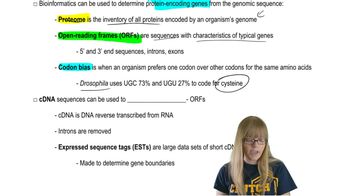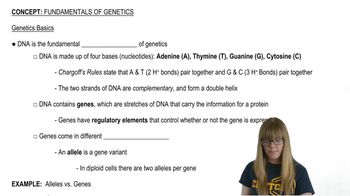Table of contents
- 1. Introduction to Genetics51m
- 2. Mendel's Laws of Inheritance3h 37m
- 3. Extensions to Mendelian Inheritance2h 41m
- 4. Genetic Mapping and Linkage2h 28m
- 5. Genetics of Bacteria and Viruses1h 21m
- 6. Chromosomal Variation1h 48m
- 7. DNA and Chromosome Structure56m
- 8. DNA Replication1h 10m
- 9. Mitosis and Meiosis1h 34m
- 10. Transcription1h 0m
- 11. Translation58m
- 12. Gene Regulation in Prokaryotes1h 19m
- 13. Gene Regulation in Eukaryotes44m
- 14. Genetic Control of Development44m
- 15. Genomes and Genomics1h 50m
- 16. Transposable Elements47m
- 17. Mutation, Repair, and Recombination1h 6m
- 18. Molecular Genetic Tools19m
- 19. Cancer Genetics29m
- 20. Quantitative Genetics1h 26m
- 21. Population Genetics50m
- 22. Evolutionary Genetics29m
15. Genomes and Genomics
Bioinformatics
Problem 8b
Textbook Question
BLAST searches and related applications are essential for analyzing gene and protein sequences. Define BLAST, describe basic features of this bioinformatics tool, and give an example of information provided by a BLAST search.
 Verified step by step guidance
Verified step by step guidance1
BLAST stands for Basic Local Alignment Search Tool, a bioinformatics program used to compare an input sequence (DNA, RNA, or protein) against a database of sequences to find regions of similarity.
The basic features of BLAST include its ability to perform local alignments, which means it finds regions of similarity within sequences that may not be globally aligned. This is useful for identifying homologous sequences.
BLAST provides several types of searches, such as BLASTn for nucleotide sequences, BLASTp for protein sequences, and BLASTx for translating nucleotide sequences into proteins and comparing them to a protein database.
A BLAST search typically provides information such as the alignment score, which indicates the quality of the match, the E-value, which estimates the number of matches expected by chance, and the identity percentage, which shows how similar the sequences are.
For example, a BLAST search can identify a gene in a newly sequenced genome by finding similar sequences in a database, providing insights into the gene's function based on known homologous sequences.
Recommended similar problem, with video answer:
 Verified Solution
Verified SolutionThis video solution was recommended by our tutors as helpful for the problem above
Video duration:
54sPlay a video:
Was this helpful?
Key Concepts
Here are the essential concepts you must grasp in order to answer the question correctly.
BLAST (Basic Local Alignment Search Tool)
BLAST is a bioinformatics tool used to compare an input sequence (DNA, RNA, or protein) against a database of sequences to identify regions of similarity. It helps researchers find homologous sequences, which can indicate functional, structural, or evolutionary relationships. By using algorithms to optimize speed and accuracy, BLAST allows for rapid identification of potential matches in large datasets.
Recommended video:
Guided course

Bioinformatics
Basic Features of BLAST
BLAST offers several key features, including the ability to perform different types of searches (e.g., nucleotide vs. protein), customizable parameters for sensitivity and speed, and various output formats. Users can select databases to search against, such as GenBank or UniProt, and can filter results based on criteria like sequence identity or alignment length. These features make BLAST versatile for various research applications.
Recommended video:
Guided course

Genetics Basics
Information Provided by a BLAST Search
A BLAST search provides valuable information, including the best matches to the input sequence, alignment scores, and statistical significance (E-values) of the matches. It also displays the alignment itself, showing how closely the sequences match, and can provide annotations about the matched sequences, such as gene names or functional descriptions. This information is crucial for understanding gene function and evolutionary relationships.
Recommended video:
Guided course

Bioinformatics

 8:28m
8:28mWatch next
Master Bioinformatics with a bite sized video explanation from Kylia Goodner
Start learningRelated Videos
Related Practice

